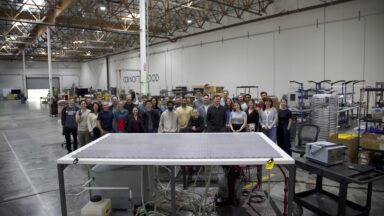
Northwood Space successfully tests second-generation phased array antenna
Northwood Space has successfully conducted initial tests of its next-generation phased array radar technology, which is designed to facilitate communication with spacecraft across various orbits, including those close to Earth and up to geostationary positions. During recent trials, the prototype gateway established connections with multiple satellites, as noted by Bridgit Mendler, the company's co-founder and CEO. This promising demonstration has bolstered Northwood's plans for commercial deployment of its antennas in the upcoming months. "This system, which is set for multinational deployment this year, will serve as the foundational element of our network, aiming to support 500 spacecraft simultaneously across diverse frequencies, data rates, and orbits over the next three years," Mendler explained. The upcoming production-ready antenna, dubbed Portal, is engineered to connect seamlessly with satellites in low-Earth, medium-Earth, and geostationary orbits. Mendler highlighted its capabilities, including delivering 1 kW of transmit power while effectively receiving sub-picowatt signals. Founded with the goal of addressing the current challenges faced by commercial ground stations in handling the increasing data demands from orbiting satellites, Northwood and its investors believe that existing ground station technologies, many of which were established over a decade ago, will struggle to keep pace with the influx of new satellites. In a recent feature, Ars detailed Northwood's initial prototype field test, which took place last October in North Dakota. Although the first connections posed some challenges, the team managed to resolve these issues within a few days. Since then, Northwood's dedicated engineers have focused on developing a more advanced second-generation antenna that is not only more durable and mobile but also easier to manufacture for commercial use. Notably, the Portal antenna incorporates a liquid cooling system, allowing it to endure extreme temperatures of up to 50° Celsius (122° F).
Federal Judge Halts FTC Inquiry into Media Matters, Raising Free Speech Concerns
In a significant ruling, a federal judge has issued a preliminary injunction that halts the Federal Trade Commission's (...
TechCrunch | Aug 16, 2025, 21:00
Senate Democrats Urge Trump to Reconsider AI Chip Sales to China
A group of six Senate Democrats has issued an open letter urging President Donald Trump to rethink his recent decision p...
CNBC | Aug 16, 2025, 17:15
The Enduring Legacy of The Rocky Horror Picture Show: Celebrating 50 Years of Cult Classic
Since its debut in 1975, The Rocky Horror Picture Show has achieved an unprecedented milestone as the longest-running th...
Ars Technica | Aug 16, 2025, 19:35
The Rise of AI-Enhanced Plush Toys: A New Era of Play or Just a Digital Substitute?
Are AI-driven chatbots embedded in adorable plush toys a practical alternative to screen time for children? Companies pr...
TechCrunch | Aug 16, 2025, 20:00
Unveiling the iPhone 17 Air: What to Expect from Apple's Next Big Release
The anticipation surrounding Apple's iPhone 17 series is building as the company prepares for a global launch event next...
Mint | Aug 16, 2025, 11:25